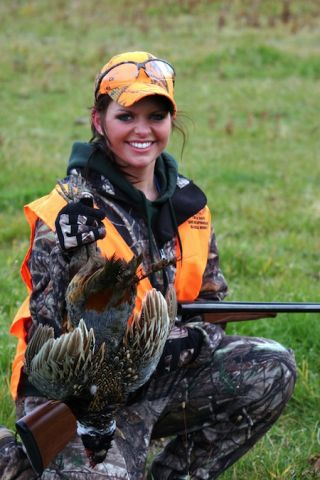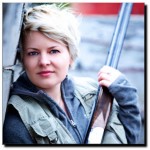According to hunting license information available from the Alaska Department of Fish and Game, the number of females who purchased resident hunting licenses in Alaska in 2011 made up approximately 19 percent of the total licenses purchased. In 2012, females purchasing resident hunting licenses accounted for 20 percent of the total purchased in the state; that means one in five hunters is female. This number represents a higher percentage of female hunters than the national average of 9 percent, reported in a comprehensive review of hunting licenses by the National Shooting Sports Foundation in 2009.

Molly Copple, born and raised in Alaska. She attended a pheasant hunt put on by the Kenai Peninsula Chapter of Safari Club International in 2011 and was featured in the book Women Hunting Alaska. Photo courtesy of Christine Cunningham
It isn’t just license numbers that are on the rise. The State of Alaska Hunters Education program tracks information about its participants, and according to Ginamaria Smith, the South Central Coordinator for the Program, statewide statistics for females who complete the Hunters Education course have increased since 2003, when 1366 participants completed the program and 13.5 percent of the participants were female. In 2012, 2382 participants took a Hunter Education class and 35.3 percent were female.
Elaina Spraker, an instructor for the Kenai Peninsula Women On Target program, led four clinics last year, most with wait lists. This year, she has increased the number of clinics, but continues to have a wait list of close to 100 women. Spraker believes that many women have wanted to learn firearm safety and skills for a longtime but have not had a comfortable setting do so. “I hear the same story over and over,” Spraker says, “‘My husband bought me a pistol, and it’s been in the night stand for a number of years, he’s tried to teach me to use it but he becomes too impatient or I don’t want him to teach me. The Women on Target coaching staff includes a group of highly skilled instructors that provide a comfortable, enjoyable atmosphere.”
As an Alaskan, Spraker noted, “Guns are a significant part of the Alaskan culture; they are a very important tool not only for protection from two and four legged animals, but equally important as a means to harvest food.” The Snowshoe Gun Club, which sponsors the clinics, has seen a rise in female members in recent years. And, in addition to the Women on Target clinics, the club sponsors a Delta Waterfowl Education Day for Youth and Women, as well as programs through Hunters Education and Becoming an Outdoors-Woman.
Since the 2006 US National Survey of Fishing, Hunting and Wildlife, the growing number of women hunters has brought a ray of hope to the decline in hunter numbers in general. With the 2012 results now in, the hunting and conservation community has taken notice of what women are bringing to the tradition–new perspectives in the field, new products to the industry and an image of hunting that carries with it a forward momentum.
In an easily overlooked addendum to the 2006 survey, Jerry Leonard, an economist with the U.S. Fish and Wildlife Service, cited an intriguing statistic that reveals just one way in which women can save the future of hunting: children are far more likely to hunt if one or both of their parents hunt. In households where the male parent hunted one to three days, sons were nine times more likely to hunt than in households where the male parent didn’t hunt. In households where the female parent hunted, the number skyrocketed. ~Christine Cunningham
 Editor’s note: Thank you, Christine Cunningham, for this update on women hunters in Alaska. Christine authored “Women Hunting Alaska.” For more information about the book, please visit Northern Publishing or like Women Hunting Alaska on Facebook!
Editor’s note: Thank you, Christine Cunningham, for this update on women hunters in Alaska. Christine authored “Women Hunting Alaska.” For more information about the book, please visit Northern Publishing or like Women Hunting Alaska on Facebook!
The Women's Outdoor News, aka The WON, features news, reviews and stories about women who are shooting, hunting, fishing and actively engaging in outdoor adventure. This publication is for women, by women. View all posts by The WON